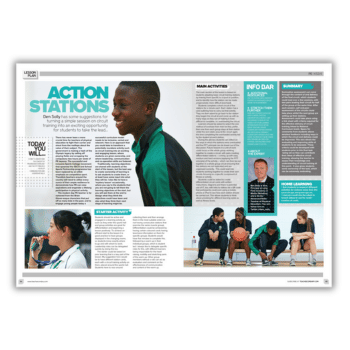Try these suggestions for turning a simple GCSE PE session on circuit training into an exciting opportunity for students to take the lead…
The modern-day PE teacher is far removed from the Brian Glover-esque characters that put off so many kids in the past. To engage young people today a successful curriculum model needs to be inclusive, varied and relevant.
Here is an approach that you could take to transform a potentially mundane activity such as circuit training into an exciting and engaging GCSE PE lesson. This lesson gives students ownership and fosters leadership, communication and co-operation skills.
Traditionally, learning objectives are shared with students at the start of the lesson. However, the best way to create ownership of learning is to ask students to create them, or at least have some input into what they will be.
I also like to have a ‘mystery lesson’ occasionally, where you say to the students that you are not going to tell them the learning objectives at the start, but you will ask them at the end to design what they think the objectives could have been and also what they think their next stage of learning might be.
Circuit training GCSE PE learning objectives
- Understand the concept of ‘progressive overload’ and the FITT principle
- Develop communication and leadership skills
Starter activity
Ensure students are active and engaged as soon as they enter the sports hall. Set a positive tone by organising group activities that allow for differentiation and build momentum for the lesson.
Display group lists in the changing rooms so students know exactly where to go and who to work with before they enter. This streamlines transitions and enables you to delegate leadership roles quickly and effectively.
Base the starter on prior learning that links to the key focus of the lesson. Place circuit training station cards around the sports hall and have students race to collect them.
Challenge them to arrange the cards in a logical order, avoiding consecutive stations that target the same muscle group.
Use differentiation by creating cards with varying levels of information, colour-coded for specific groups. Allow students five minutes to complete the task, then transition into a student-led warm-up within their groups.
Delegate specific roles for the warm-up, with different students responsible for the heart-raising, mobility and stretching sections.
Assign remaining group members as evaluators to provide feedback on communication and the quality of the warm-up.
Ben Solly is Vice Principal at Long Field Academy in Melton Mowbray, and a former Advanced Skills Teacher of Physical Education.










